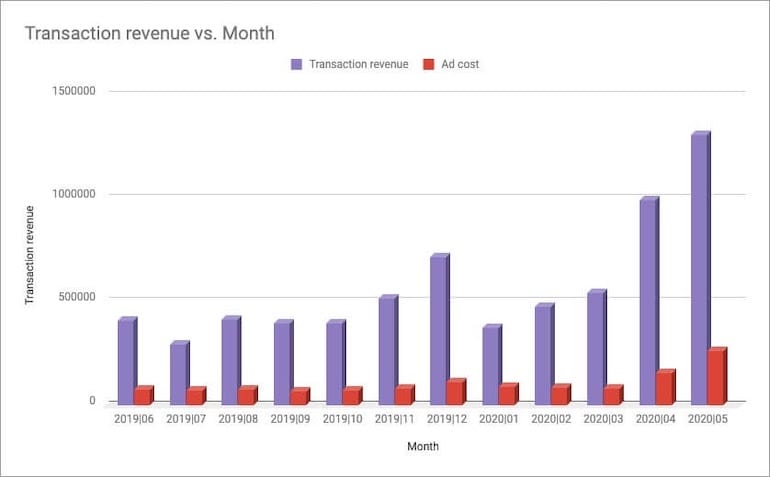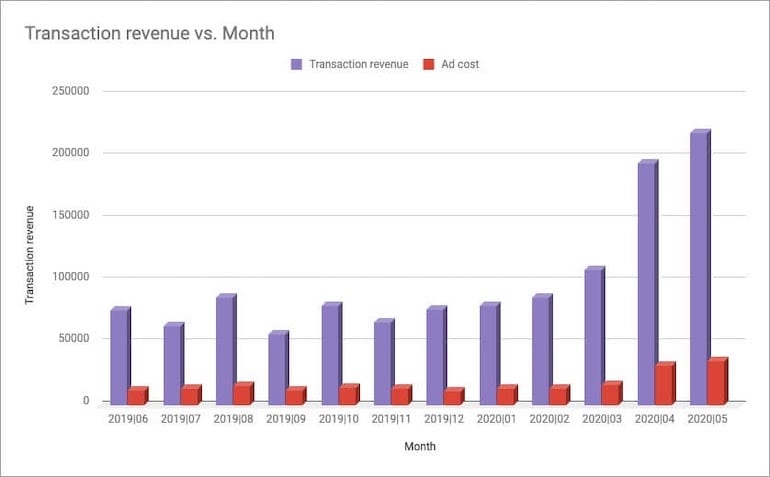There is no doubt the recent stay-at-home orders have impacted businesses in a big way. Some businesses have experienced significant revenue loss, while some eCommerce companies are seeing record revenue months. The current pandemic has changed search behavior as more people shift to buying online. Many eCommerce businesses have experienced an increase in conversion rate performance, especially those who carry products for projects that can be done at home.
In this article, I will discuss experiences from a few different eCommerce businesses that carry DIY products and the impacts on their business from the stay-at-home period. We will also discuss some ways any advertiser can maximize revenue for similar DIY product brands during this unprecedented time.
A Luxury DIY Brand’s Paid Media Performance During The Stay-At-Home Period
In one Luxury DIY account, they experienced a slight dip in revenue, but quickly recovered in March and experienced record-high revenue in April and May. Their products are classified as luxury and not considered an impulse buy. Purchasing these products requires planning and includes many custom order options.

Automotive Parts Brands’ Paid Media Performance During The Stay-At-Home Period
For one automotive accessories brand, April was a record revenue month. This brand provides interior and exterior auto accessories for your vehicle. While these products are not an impulse purchase, they would be considered an upgrade or add-on products for your vehicle. As you can see in the graph below, this brand surpassed $950,000 in paid media revenue in April and $1,300,000 in May. In the past year, paid media never drove more than $750,000 in direct revenue in one month, meaning April & May’s performance was exceptional.

Another automotive accessories brand also experienced record revenue in May. This brand sells exterior auto accessories for your vehicle that are different from the brand above but in the same category.

How Any Paid Media Marketer Can Maximize Revenue During An Unexpected Event
While much of this exceptional performance is due to a change in search behavior, an increase in DIY projects, and increased e-commerce shopping, we also made some bid & budget optimizations to help maximize revenue. It is highly likely these brands would have experienced revenue growth had they just rode the wave of demand and not deviated from the original paid media strategy, but they all remained flexible during this unique time and took recommendations to do the following:
1. Increase Paid Media Budgets To Meet Increased Demand
One thing each of these brands did was increase their paid media budgets to reduce any loss of search impression share due to budget. As shoppers increased their search activity, we increased campaign budgets for additional impressions.
2. Run Additional Promotions
All three brands added promotions to their campaigns and websites. They offered these promotions over an extended period of time compared to their normal discounts which last for a few days or a week. These discounts were highlighted in the ad copy as well as Google promotion extensions.
3. Increase or Decrease Bids Based On The New Data
Bids were increased in ad groups losing search impression share due to rank if ROAS was positive. This allowed ads to show more aggressively and avoid losing impressions due to lower ad rank than our competitors. We also decreased bids in any ad group that was performing poorly or not generating revenue.
4. Perform A Search Query Analysis And Adjust According To The Insights
As a result of increasing the budget, we did spend time running search query analyses to find and exclude underperforming keywords. We found that shopping campaigns required more time and attention when excluding underperforming search terms. These campaigns have Target ROAS bid strategies and the significant budget increases seemed to result in the algorithm throwing the campaigns into auctions with broader, non-converting search terms.
Before You Make Major Adjustments, Factor in the Purchase Lag Time
With eCommerce brands, you should always factor in the account’s lag time in your decisions. For example, one of these brands has an average 15-day lag from the time an ad is clicked until most of the resulting revenue from that click is attributed to the account. Essentially, our paid media spend is often 2 weeks ahead of the resulting purchases. The paid search or shopping campaigns for these brands often appear to have poor ROAS at the beginning of the month for this reason.

Closing Thoughts
Advertising during this pandemic has required flexibility, weekly optimizations, and frequent adjustments to strategy. As the country begins to open back up you may find performance beginning to change again, especially since some states are opening faster than others. However, it is likely that many people will continue to order online during this time of uncertainty. Keep the above tips in mind as you aim to maximize paid media revenue.



